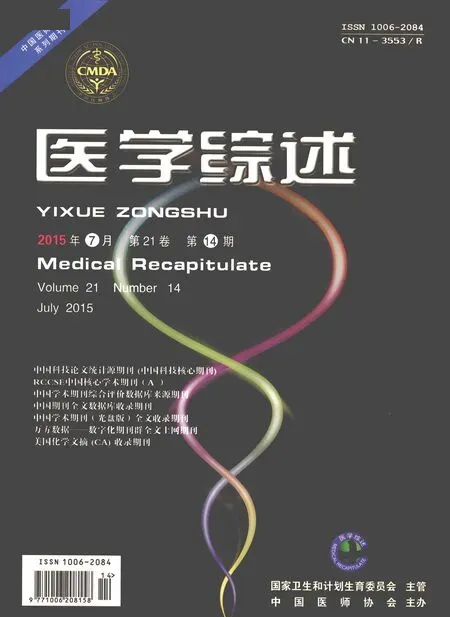大環內酯類抗生素治療類風濕關節炎的機制研究進展
郭茹茹(綜述),曹蘭芳,孔憲明(審校)
(上海交通大學醫學院附屬仁濟醫院兒科,上海 200001)
?
大環內酯類抗生素治療類風濕關節炎的機制研究進展
郭茹茹△(綜述),曹蘭芳※,孔憲明(審校)
(上海交通大學醫學院附屬仁濟醫院兒科,上海 200001)
摘要:類風濕關節炎(RA)是一種累及多關節且進行性破壞的慢性炎癥性系統性自身免疫性疾病,免疫系統的紊亂在疾病的演變中起重要作用。用于治療RA的非甾體消炎藥、改善病情的抗風濕藥、糖皮質激素、生物制劑等均只降低疾病活動度以及誘導緩解,而不能完全控制關節破壞。近年來,大環內酯類抗生素作為輔助治療,其抗感染和免疫調節作用在RA中的應用備受關注,為RA的治療提供了一種新的手段。
關鍵詞:類風濕關節炎;大環內酯類抗生素;作用機制
類風濕關節炎(rheumatoid arthritis,RA)是以持續關節滑膜增生、軟骨侵蝕、關節損壞為主要特征的累及多關節的系統性疾病。近年有文獻指出炎性因子持續激活、機體調節異常、自身抗原刺激的異常免疫反應以及合并慢性感染性疾病為RA患者關節炎癥持續存在的主要因素[1-2]。因此,從免疫調節的層面進行干預,及時發現感染并治療成為RA治療的新突破,其中越來越受重視的大環內酯類抗生素(macrolide antibiotics,MA)在RA治療中的免疫調節及抗感染作用成為目前研究的熱點[3]。MA是一種具有內酯鍵的大環狀生物活性物質,有獨立于抗菌功能的抗炎作用和免疫調節作用[4-5]。2002年 Savilola等[6]首次報道,紅霉素、克拉霉素、阿奇霉素等MA可改善RA患者的癥狀,對RA治療具有一定的意義。現對MA治療RA的機制研究進展進行綜述。
1MA在RA中的抗感染作用
影響RA的預后因素有很多,比如生活習慣(如吸煙)、支原體感染、牙周炎等,其中牙周炎是研究的熱點,且認為可能是導致RA的病因之一[7]。大量的流行病學顯示[7-8],RA患者的牙周炎發病率極高,其中一項以醫院為基礎的病例對照研究中發現100個RA患者都患有牙周炎[9],而且牙周炎和RA之間的疾病活動情況存在正相關關系,兩者互為危險因素。在實驗室的研究中也發現,導致牙周炎的主要病原體牙齦卟啉單胞菌的DNA以及針對該病原體的抗體IgG和IgA出現在RA患者的血清和關節滑液中,而且滴度水平明顯升高,提示這些導致牙周炎的病原體參與了RA的發病過程[8]。而MA對口腔牙齦卟啉單胞菌有著積極的療效[10],通過作用于細菌核糖體50S亞單位,阻斷細菌體蛋白合成和信使核糖核酸移位,進而起到抗菌作用。
2MA對RA慢性炎癥的影響
2.1MA對RA炎性細胞的抑制作用隨著發病機制的深入研究發現,輔助性T細胞(T helper cell,Th)1/Th2以及Th17/調節性T細胞(regulatory T cells,Treg)的失衡在RA發生、進展有著重要作用[11]。Th1介導分泌的白細胞介素(inerleukin,IL) 1β在RA患者炎癥反應和滑膜組織、骨、軟骨以及關節的破壞中起到核心作用,促進關節血管翳的形成[12],而Th2分泌的抗炎因子IL-10不足以控制過度Th1介導的免疫反應。
在RA患者外周血以及關節腔內均發現有大量Th17細胞[13]。研究發現,IL-17誘導腫瘤壞死因子α(tumor necrosis factor α,TNF-α)、IL-6、IL-1β、核因子κB受體活化子配體(receptor activator of nuclear factor-kappa B ligand,RANKL)以及介導骨、軟骨破壞的基質金屬蛋白酶(matrix metalloproteinases,MMPs)的產生,IL-17表達增高與RA關節破壞的嚴重程度以及RA病情活動程度都具有相關性[14]。而具有免疫負性調節功能的Treg比例在RA患者外周血減少且存在著功能異常[15]。由此可見促進炎癥發展的Th1以及Th17反應過度,而且抗炎反應的Th2和Treg減弱或者缺陷是RA疾病進展的重要因素。
Ding等[16]研究結果顯示,小劑量的克拉霉素可以通過下調Th1細胞特異性轉錄因子T-bet及細胞因子γ干擾素的表達,阻斷Th1細胞的分化形成,通過下調Th17細胞特異性轉錄因子孤兒核受體及細胞因子IL-17的表達,阻斷Th17細胞的分化形成,從而降低Th1細胞以及Th17細胞介導的炎癥反應。紅霉素可能通過調節樹突狀細胞的功能向Treg細胞發展,而且紅霉素還可以上調Foxp3轉錄因子以及IL-35的產生,IL-35又可能促進Treg細胞的增殖[17],這對調節Th1/Th2、Th17/Treg失衡有重要作用。另有研究指出克拉霉素能顯著抑制Th1分泌的IL-1和TNF-α的合成[18],而且克拉霉素能夠抑制RA關節液中的成纖維樣滑膜細胞(fibroblast-like synoviocytes,FLSs)分泌TNF-α、IL-1β以及IL-6等炎性因子。在對淋巴細胞的作用中,研究發現[19]克拉霉素在體外可以抑制人類淋巴細胞的激活,協同地提高淋巴細胞對地塞米松抑制的敏感性,這有利于優化糖皮質激素在RA治療中的抗炎作用,這意味對RA中過度激活的T淋巴細胞有一定的抑制作用并且提高對糖皮質激素的敏感性。基于以上理論,MA在介導RA的重要炎性細胞(T細胞、樹突狀細胞、FLSs等)環節中都有一定的調節作用,這提示MA可能成為RA的輔助治療藥物,但是目前尚缺乏大樣本的研究。
2.2MA對RA黏附分子的作用近期強調RA早期中性粒細胞起著至關重要的作用。在RA炎癥狀態下,中性粒細胞產生大量黏附分子以及MMPs導致骨和軟骨的破壞;炎癥情況下的中性粒細胞出現凋亡減少、產生大量活性氧、激活T淋巴細胞等,進一步加重RA的病理過程[20],而且來源于RA患者關節液的中性粒細胞表達RANKL和核因子κB受體激動劑(receptor activator of nuclear factor-kappa B,RANK),因此中性粒細胞通過膜結合RANKL參與了骨吸收。
研究表明,MA能夠抑制中性粒細胞的遷移[21],通過降低細胞間黏附分子(intercellular adhesion molecule,ICAM)1的合成和表達;干預β2整合素;影響中性粒細胞的激活;降低中性粒細胞趨化因子白三烯B4的合成;MMPs利于中性粒細胞的遷移,MA通過抑制NF-κB和轉錄因子激活蛋白(activator protein,AP)1的激活來干預MMP2、7、9的合成和釋放。RA滑膜成纖維樣細胞刺激黏附分子的合成和表達,比如血管細胞黏附分子(vascular cell adhesion molecule,VCAM)1、ICAM-1,這些黏附分子加速炎性細胞聚集、加強中性粒細胞和基質蛋白的反應,進一步加劇關節的破壞,該研究發現使用特異性蛋白阻斷ICAM-1、VCAM-1能抑制膠原誘導性關節炎和佐劑性關節炎[22]。研究顯示,14環MA可以抑制黏附分子如E-選擇素、VCAM-1和ICAM-1的信使RNA表達[21],這可以通過抑制中性粒細胞的遷移以及減輕中性粒細胞介導的炎癥反應進而有利于RA關節炎癥的控制。MA還可以通過抑制黏附分子的表達進而阻止多型核細胞在關節中的聚集,減輕多型核細胞介導的局部炎癥反應[19]。
2.3MA對RA細胞因子的作用在參與RA的眾多炎性因子中,IL-6是一個多效性的細胞因子,參與了Th1/Th2的平衡以及Th17/Treg的平衡[23]。RA患者關節液中高水平的IL-6/IL-6R復合物與RA關節的破壞以及疾病持續進展密切相關:IL-6/IL-6R復合物誘導細胞表面gp130的表達,而gp130激活JAK酪氨酸激酶誘導信號轉導和轉錄活化因子3(signal transducer and activator of transcription 3,STAT3)酪氨酸磷酸化,而STAT3與破骨細胞的形成密切相關,RA患者關節液FLSs中RANKL的表達是由IL-6/可溶性IL-6受體(soluble IL-6 receptor,SIL-6R)/JAK2/高表達細胞因子信號轉導3(suppressor of cytokine signaling 3,SOCS3)通路所調控[24]。目前IL-6及其通路的相關抑制劑在RA中的應用是RA治療的一個重大突破。而且文獻報道MA具有抗炎作用,其中對細胞因子的影響主要表現在減少促炎因子的產生,如IL-6、IL-8等[25];Migita等[24]研究指出,MA在IL-6刺激下的FLSs中能通過抑制STAT3的表達進而影響RANKL的表達,進一步影響骨代謝,減輕RA關節的破壞。在體外的一項研究中發現紅霉素、克拉霉素、阿奇霉素以及羅紅霉素以濃度依賴的方式降低由脂多糖刺激的巨噬細胞分泌TNF-α、IL-1β以及IL-6等炎性因子分泌[19],同樣在膠原誘導的關節炎小鼠模型中也顯示羅紅霉素能降低小鼠血清中的IL-6以及減輕小鼠關節炎的嚴重程度。
2.4MA在RA凋亡中的作用中性粒細胞在RA出現正常凋亡受到抑制以及過度激活的T淋巴細胞導致炎癥的持續存在。由此可見,及時誘導中性粒細胞、過度激活的T淋巴細胞凋亡能起到抗炎的作用[26]。研究發現,MA能誘導激活的中性粒細胞的凋亡:紅霉素增加環腺苷酸的水平,在24 h內加速中性粒細胞的凋亡[21],而體外的研究也顯示羅紅霉素可以通過增強Fas-FasL和caspase-3的表達,誘導活化的T細胞的凋亡,并不具有濃度依賴性。Thanou-Stavraki等[19]發現MA還可以通過促進細胞凋亡以及凋亡細胞的吞噬作用來降低多型核細胞的生存周期,減輕關節炎的炎癥反應。
2.5MA在RA細胞信號轉導中的作用在RA骨侵蝕部位可發現活化T淋巴細胞和FLSs分泌RANKL,同時也發現RANKL的受體RANK表達增加,兩者結合通過激活T細胞核因子1蛋白(nuclear factor of activated T-cells cytoplasmic 1,NFATc1)促進破骨細胞形成、分化與激活,引起RA軟骨基質破壞[27-28]。而RANKL處于NF-κB的上游,NF-κB的活化受到RANKL的調控。RANKL促進NF-κB產生,進而促使多種炎性細胞因子產生和釋放(IL-6、IL-1β、TNF-α、前列腺素E2、環氧合酶2等),成為RA炎癥反應的關鍵環節[29-30]。
近年來大量研究顯示[21,31-32],紅霉素能通過直接抑制RANKL表達減少NF-κB的信使核糖核酸表達,減少組織蛋白酶K、IL-1β、IL-8、TNF-α等的產生和釋放,控制炎癥的進展;同時可以通過抑制RANKL的表達,阻滯破骨細胞的分化,減少關節破壞。在一項關于阿奇霉素對人類破骨細胞形成和骨吸收活動的體外研究中發現[4],阿奇霉素同樣能明顯抑制RANKL刺激的骨吸收活動,降低破骨細胞轉錄因子NFATc1的信使RNA和蛋白質的表達,而NFATc1在破骨細胞黏附、遷移、酸化和骨基質降解起關鍵性作用。NF-κB的激活能夠在轉錄水平促進炎癥因子的基因表達,導致炎癥的爆發,而研究表明紅霉素和羅紅霉素通過阻止NF-κB的活化,進而控制過度的炎癥反應[5]。阿奇霉素可以通過調節Toll樣受體4的表達,從而減少其下游的核因子NF-κB的產生,達到抑制炎癥反應的目的[33]。這些提示紅霉素、阿奇霉素、羅紅霉素主要通過調控RANKL-RANK對人類破骨細胞功能有著直接的抑制作用,有望成為抑制RA關節破壞的輔助治療藥物。
3結語
RA的發病機制十分復雜,在研究中發現中性粒細胞、巨噬細胞、FLSs、T細胞、B細胞等均參與了疾病的發生、發展,這些細胞的過度激活及其刺激產生的炎性因子使機體處于一個持續炎癥刺激狀態,導致疾病的不斷進展。而基于以上的論述,MA在RA的相關發病環節有一定的干預效果,有望成為RA的輔助治療藥物,但是對于MA治療的劑量、療程以及耐藥的問題仍需要大量的臨床實踐來進一步探討。
參考文獻
[1]Caporali R,Bugatti S,Cavagna L,etal.Modulating the co-stimulatory signal for T cell activation in rheumatoid arthritis:Could it be the first step of the treatment?[J].Autoimmun Rev,2014,13(1):49-53.
[2]Kaur S,White S,Bartold PM.Periodontal disease and rheumatoid arthritis:a systematic review[J].J Dent Res,2013,92(5):399-408.
[3]Zarogoulidis P,Papanas N,Kioumis I,etal.Macrolides:from in vitro anti-inflammatory and immunomodulatory properties to clinical practice in respiratory diseases[J].Eur J Clin Pharmacol,2012,68(5):479-503.
[4]Gannon SC,Cantley MD,Haynes DR,etal.Azithromycin suppresses human osteoclast formation and activity in vitro[J].J Cell Physiol,2013,228(5):1098-1107.
[5]Asano K,Tryka E,Cho JS,etal.Macrolide therapy in chronic inflammatory diseases[J].Mediators Inflamm,2012,2012:692362.
[6]Saviola G,Abdi Ali L,Rossini P,etal.Clarithromycin in rheumatoid arthritis patients not responsive to disease-modifying antirheumatic drugs:An open,uncontrolled pilot study[J].Clin Exp Rheumatol,2002,20(3):373-378.
[7]Rosman Y,Lidar M,Shoenfeld Y.Antibiotic therapy in autoimmune disorders[J].Clin Pract,2014,11(1):91-103.
[8]Ogrendik M.Rheumatoid arthritis is an autoimmune disease caused by periodontal pathogens[J].Int J Gen Med,2013,6:383-386.
[9]Joseph R,Rajappan S,Nath SG,etal.Association between chronic periodontitis and rheumatoid arthritis:a hospital-based case-control study[J].Rheumatol Int,2013,33(1):103-109.
[10]Ogrendik M,Karagoz N.Treatment of rheumatoid arthritis with roxithromycin:a randomized trial[J].Postgrad Med,2011,123(5):220-227.
[11]Ahmad SF,Zoheir KM,Abdel-Hamied HE,etal.Amelioration of autoimmune arthritis by naringin through modulation of T regulatory cells and Th1/Th2 cytokines[J].Cell Immunol,2014,287(2)112-120.
[12]Qi J,Ye X,Ren G,etal.Pharmacological efficacy of anti-IL-1β scFv,Fab and full-length antibodies in treatment of rheumatoid arthritis[J].Mol Immunol,2014,57(2):59-65.
[13]Zizzo G,De Santis M,Bosello SL,etal.Synovial fluid-derived T helper 17 cells correlate with inflammatory activity in arthritis,irrespectively of diagnosis[J].Clin Immunol,2011,138(1):107-116.
[14]Noack M,Miossec P.Th17 and regulatory T cell balance in autoimmune and inflammatory diseases[J].Autoimmun Rev,2014,13(6):668-677.
[15]Nie H,Zheng Y,Li R,etal.Phosphorylation of FOXP3 controls regulatory T cell function and is inhibited by TNF-[alpha] in rheumatoid arthritis[J].Nat Med,2013,19(3):322-328.
[16]Ding FM,Zhu SL,Shen C,etal.Low-dose clarithromycin therapy modulates CD4+T-cell responses in a mouse model of chronic Pseudomonas aeruginosa lung infection[J].Respirology,2012,17(4):727-734.
[17]Bai J,Qiu SL,Zhong XN,etal.Erythromycin enhances CD4+Foxp3+regulatory T-cell responses in a rat model of smoke-induced lung inflammation[J].Mediators Inflamm,2012,2012:410232.
[18]Saviola G,Abdi-Ali L,Campostrini L,etal.Clarithromycin in rheumatoid arthritis:the addition to methotrexate and low-dose methylprednisolone induces a significant additive value—a 24-month single-blind pilot study[J].Rheumatol Int,2013,33(11):2833-2838.
[19]Thanou-Stavraki A,Aberle T,Aksentijevich I,etal.Clarithromycin in Adult-Onset Still′s Disease:A Potentially Useful Therapeutic[J].J Clin Rheumatol,2011,17(7):373-376.
[20]Cascao R,Rosario HS,Souto-Carneiro MM,etal.Neutrophils in rheumatoid arthritis:More than simple final effectors[J].Autoimmun Rev,2010,9(8):531-535.
[21]Kanoh S,Rubin BK.Mechanisms of action and clinical application of macrolides as immunomodulatory medications[J].Clin Microbiol Rev,2010,23(3):590-615.
[22]Ahmed S,Riegsecker S,Beamer M,etal.Largazole,a class I histone deacetylase inhibitor,enhances TNF-α-induced ICAM-1 and VCAM-1 expression in rheumatoid arthritis synovial fibroblasts[J].Toxicol Appl Pharmacol,2013,270(2):87-96.
[23]Atsumi T,Singh R,Sabharwal L,etal.Inflammation amplifier,a new paradigm in cancer biology[J].Cancer Res,2014,74(1):8-14.
[24]Migita K,Izumi Y,Jiuchi Y,etal.Effects of Janus kinase inhibitor tofacitinib on circulating serum amyloid A and interleukin-6 during treatment for rheumatoid arthritis[J].Clin Exp Immunol,2014,175(2):208-214.
[25]Cervin A,Wallwork B.Efficacy and safety of long-term antibiotics (macrolides) for the treatment of chronic rhinosinusitis[J].Curr Allergy Asthma Rep,2014,14(3):416.
[26]McGrath EE,Marriott HM,Lawrie A,etal.TNF-related apoptosis-inducing ligand (TRAIL) regulates inflammatory neutrophil apoptosis and enhances resolution of inflammation[J].J Leukoc Biol,2011,90(5):855-865.
[27]Ellabban AS,Kamel SR,Ahmed SS,etal.Receptor activator of nuclear factor kappa B ligand serum and synovial fluid level.A comparative study between rheumatoid arthritis and osteoarthritis[J].Rheumatol Int,2012,32(6):1589-1596.
[28]Crotti TN,Dharmapatni AA,Alias E,etal.The immunoreceptor tyrosine-based activation motif (ITAM)-related factors are increased in synovial tissue and vasculature of rheumatoid arthritic joints[J].Arthritis Res Ther,2012,14(6):R245.
[29]Naidu VG,Dinesh Babu KR,Thwin MM,etal.RANKL targeted peptides inhibit osteoclastogenesis and attenuate adjuvant induced arthritis by inhibiting NF-κB activation and down regulating inflammatory cytokines[J].Chem Biol Interact,2013,203(2):467-479.
[30]Jeoung BR,Lee KD,Na CS,etal.Ganghwaljetongyeum,an anti-arthritic remedy,attenuates synoviocyte proliferation and reduces the production of proinflammatory mediators in macrophages:the therapeutic effect of GHJTY on rheumatoid arthritis[J].BMC Complement Altern Med,2013,13(1):47.
[31]Triantafillopoulos IK,Papaioannou NA.The Effect of Pharmacological Agents on the Bone-Implant Interface[M]// Karachalios T.Bone-Implant Interface in Orthopedic Surgery.11th ed.New York:Springer,2014:221-237.
[32]Mencarelli A,Distrutti E,Renga B,etal.Development of non-antibiotic macrolide that corrects inflammation-driven immune dysfunction in models of inflammatory bowel diseases and arthritis[J].Eur J Pharmacol,2011,665(1):29-39.
Research Progress in Mechanisms of Macrolide Antibiotics on Rheumatic ArthritisGUORu-ru,CAOLan-fang,KONGXian-ming. (DepartmentofPediatrics,RenjiHospital,SchoolofMedicine,ShanghaiJiaotongUniversity,Shanghai200001,China)
Abstract:Rheumatic arthritis(RA) is a chronic inflammatory systemic autoimmune disease that is characterized by polyarthritis with progressive joint damage,in which immune system disorder plays an important role.A variety of antirheumatic treatments,including non-steroidal anti-inflammatory drugs,anti-rheumatic drugs,glucocorticoids,biologic agents,which can only reduce the disease activity and induce remission,but not completely control the joint damage.Recently,macrolide antibiotics as an adjuvant therapy in RA,has drawn much attention for its antibacterial activity and immunomodulatory effects,offering a new option for RA treatment.
Key words:Rheumatic arthritis; Macrolide antibiotics; Mechanism
收稿日期:2014-07-21修回日期:2014-10-29編輯:相丹峰
doi:10.3969/j.issn.1006-2084.2015.14.042
中圖分類號:R453.9
文獻標識碼:A
文章編號:1006-2084(2015)14-2608-03

